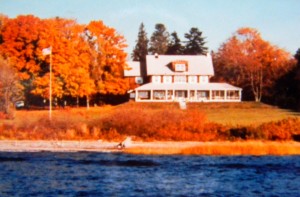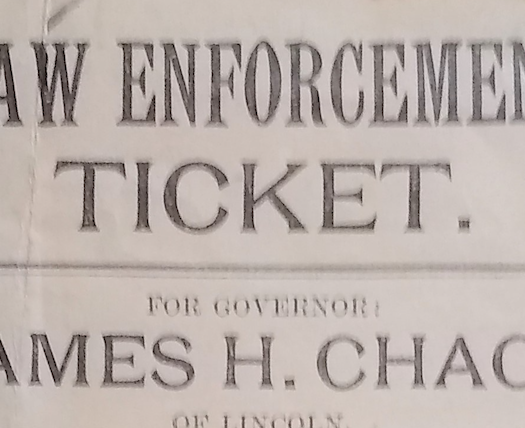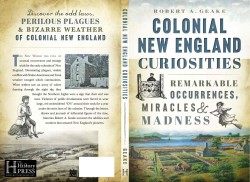In Kent County, after more than a century of temperance supporters promoting laws banning the sale of alcohol, and the sometimes, violent opposition to such efforts, those in the temperance movement seemed to have won a victory. On December 1, 1917, the U.S. Congress adopted the Eighteenth Amendment to the U.S. Constitution. The amendment provided that within a year after its ratification by three-fourths of the states the importation, sale, transport, and manufacture of “intoxicating liquors” would be prohibited.
The thirty-sixth state ratified the amendment in January 1919. Then Congress passed enabling legislation to enforce prohibition and define it. The Volstead Act, passed in October 1919, declared that after New Year’s Day of 1920 all traffic in beverages that contained more than one-half of one percent of alcohol by volume was illegal. Rhode Island, which had not voted to adopt the Eighteenth Amendment, was bound by the new law and, on paper anyway, was obligated to enforce it.
After passage of the Volstead Act, speakeasies abounded in the villages of Apponaug, East Greenwich and Old Warwick, as well as in Warwick Neck, and smuggling became rampant on the shores of Rhode Island. Local historian Mathias P. Harpin alluded to the availability of liquor in “Jericho,” the early name of the village of Arctic, in his native West Warwick:
No matter how many raids were staged, nothing could stem the flow of “alky” in Jericho. It came out of cellars, woodsheds, garages, privies, attics, barns, abandoned factories, chicken coops. It was delivered in five-gallon tins, wooden casks, glass jugs, kegs, and flasks. Jericho boasted that it was wide open. Prevailing conditions in the speakeasies of the region made a mockery of the old saloon days. Crowds poured into Jericho Friday and Saturday nights to break all records.[1]
Much of the illegal contraband was transported to Rhode Island by sea. With its abundance of quiet coves and creeks, the state was ideal for bootlegging. But what was once accomplished by a rowboat, a strong rower, and a man with a good spyglass had changed entirely. The twentieth century brought speedboats and radar equipment onto Narragansett Bay. Unchanged however, was the state’s long-standing reputation for corruption.
In 1925, a scandal broke when it was found that the Coast Guard crew stationed on Block Island and assigned to patrol Narragansett Bay had been paid off to look the other way when certain boats plied the waters at night. Speedboats entered the West Passage and found their way to hidden piers and low-lying islands that were usable at low tide. Even fishing and clamming boats took the opportunity at times for rum running. One shellfish dealer did well simply by hiding liquor bottles in barrels beneath his haul of quahogs.
One of the most notorious bootleggers during this era of prohibition was Carl Rettich. Known to his Warwick Neck neighbors as Charles Ryerson, most people in the summer community believed him to be a respectable lawyer who had moved to Rhode Island to care for his aging father. The truth was that Rettich was tied to organized crime, with links to Al Capone and other prominent gangsters. Prior to his arrival in Rhode Island, the liquor smuggled into the state was controlled by Danny Walsh, a prominent Charlestown, Rhode Island horse breeder who kept political allies and bankers stocked with hard liquor. Rettich soon became his partner, and with assistance from Walsh’s banking connections, the operation expanded into Greenwich Bay in East Greenwich.
Rettich purchased the grand, twenty-room mansion on the coast of Warwick Neck, on Kirby Road, built by music impresario Felix Wendelshaefer in 1901. It was an ideal location for a bootlegger. With a stone dock that jutted out from the rocky coast into the deeper water, it allowed fast cruising speedboats to slip easily in and out of the cove.
According to Warwick historian Donald D’Amato, the speedboats were “powered by three Liberty airplane engines each. They were armor plated with layers of New York telephone directories to ward off the Coast Guard machine-gun fire. These boats would go out to the twelve-mile limit, known as ‘Rum-Row’ to meet the ocean-going vessels.”[2]
Rettich’s boats would load up with contraband liquor offshore and speed it away to various dropping points along the Rhode Island coast. The business expanded and prospered, but it suffered a setback in late 1929. Early in the morning of December 29, a Coast Guard vessel came within sight of one of the most successful smuggling boats of the time. Named the Black Duck, and reputed to be owned by Rettich, the boat had just taken on 383 sacks of liquor from a British ship outside Narragansett Bay and twelve miles beyond U.S. territorial waters. Coast Guard Boatswain Alexander Cornell had tied his patrol boat to a buoy near The Dumplings, an outcropping of rocks off Jamestown, with the lights of Newport in distance. Sure enough, at 2:15 in the morning, with the fog lifting, Cornell spotted the Black Duck drawing close to the harbor. He turned his searchlight on the speedy rumrunner and sounded his Klaxon horn, a signal for the boat to stop. When the Black Duck continued, he ordered the vessel strafed with machine-gun fire. The sole survivor of the boat, the pilot wounded in his hand, surrendered shortly afterward—three of his crewmen lay dead.
Cornell however, was not seen as a hero. Rhode Islanders were outraged at the violence committed in their bay and pressured the Coast Guard into investigating the strafing of the craft. Even local preachers railed against the government shooting at citizens without due cause, based solely on suspicion. Cornell was finally exonerated by a Rhode Island grand jury, which determined that his crew had given the Black Duck sufficient warning to surrender before opening fire.[3]
Then in early February 1933, Danny Walsh disappeared. Witnesses had seen Walsh with Rettich and his young associate—nicknamed “Wireless”—at Bank Café in Pawtuxet, with two other unidentified men. Rettich and Walsh were seen arguing; clearly they had a falling out. The next day the horse breeder disappeared just after visiting a bank in Providence.
Word went around in gangster circles that Walsh’s body had been taken to the cellar of Rettich’s estate, where it had been placed in a barrel and filled with cement and then taken out to sea from Greenwich Cove. (This was the genesis of the legend of mobsters threatening to send a victim to the bottom of the ocean wearing “cement shoes”). Though suspicion swirled around Rettich, the authorities had no clear evidence with which to charge him with the death or kidnapping Walsh.
The police had some information on Rettich’s illegal activities following the arrest of Herbert Hornstein in connection with the robbery of a Fall River mail truck in January of 1934. “College Boy,” as his associates called him, was a Brown University graduate who was on the fringes of organized crime in Rhode Island. He likely thought he had acquired his big break when Andrino Merola and Joseph Fisher, two Rettich associates, hired him for the simple task of obtaining false license plates for the vehicles the two would use in perpetrating the planned robbery. Hornstein registered a car under the name of one Peter Dubois of Pawtucket. The weakest link in the Rettich gang, Dubois would make the mistake of using his address on the false registration form.
An alert witness to the getaway from the Fall River robbery had alertly jotted down the license plate number, and when police investigators found the registration to be false, they obtained information that led them to look for Hornstein. College Boy, meanwhile, had been forewarned and fled all the way to California, but he was arrested after he attempted to deposit a twenty dollar bill taken from the hold-up into an account in a Hollywood bank.
Once returned to Rhode Island, Hornstein quickly confessed to his part in the robbery and implicated Merola and Fisher, as well as Rettich. College Boy further detailed to police the gangster’s criminal activities taking place at his Warwick Neck estate. Based on Hornstein’s evidence, Providence police assigned Captain Francis J. Buchanan to work undercover to keep the waterfront home under surveillance.
On April 17, 1935, the lifeless body of Andrino Merola was found in Wrentham, Massachusetts. Merola had been murdered, and at this time the police had been searching for Rettich on the basis of Hornstein’s statements. The police next obtained a warrant to search Rettich’s house. State troopers were brought onto the estate. Initially, searchers attempted to locate a tunnel and underground chamber whose existence had been disclosed by Hornstein. A day-long search yielded nothing from either the grounds or the cellar, which was thoroughly clean with four brick, white-washed posts supporting the floor beams above.
To one inspector, the posts looked too clean; he searched them again, even more carefully. Finally he located a large screw in one of the posts. When detectives turned the screw, a large section of the concrete floor rose slowly to the ceiling, revealing a set of steps leading down to a seventy-five foot long concrete room. The vault was empty but for a few beer cans, but its discovery fuelled the rumors of Danny Walsh’s disappearance.
The house was found to hold an arsenal that included machine guns, sawed-off shotguns, three bullet-proof vests, revolvers, silencers, and 15,000 rounds of ammunition. In addition, a car with bullet holes in it was discovered on the property.
The State Police hired workers from the government’s E.R.A. relief program (later the W.P.A.) to assist in searching the grounds. They were tasked with tearing up anything concrete within the estate, and digging in other places of interest as designated by the police. Workers quickly uncovered a five-pound sugar bag filled with nickels and then a box containing more than $10,000 of paper money that was later identified as part of the loot from the Fall River robbery.
By the end of the month, police had arrested Rettich’s associate, Joseph Fisher, and had accumulated substantial evidence implicating the smuggler’s involvement with the disappearance of Danny Walsh, as well as with robberies of a dozen Massachusetts banks and four gangland-style murders. The gangster boss turned himself in to authorities on April 30, 1935, but the evidence of his criminal activities was only just beginning to come to light.
At the Warwick Neck home, workers breaking up the concrete floor of the garage unearthed another vault, this one measuring ten feet-by-eight feet, and six feet deep. By May 5, police had been led to a garage in Hoxsie, Massachusetts, where a customized truck belonging to Rettich was stored. It included a hidden six-foot high, two-foot-wide compartment that easily was able to hide both men and stolen goods from the prying eyes of the police.
For a time, the police thought they had evidence of Walsh’s murder, based upon blood found in the vault beneath the Rettich’s house, but when it was tested, it proved to be animal blood. The murder charge against Rettich was dropped from the State’s case.
Rettich, Fisher, and two others were tried and found guilty of the Fall River robbery, but the gangster boss had one more trick up his sleeve. Obtaining the names of men in jail who were being held on low bail, he hired friends to come as “bondsmen” to the jail, during a time when a guard whom Rettich had paid off would let them inside. Rettich’s men would carry not money in their brief cases, but machine guns. The bold plan was for Rettich and his cohorts to “blast their way out of the jail.”[4]
Somehow, the police had been tipped off. On the appointed day, the so-called “bondsmen” found the jail patrolled by an extra contingent of state troopers, and the plan was quickly abandoned. Rettich never had another opportunity to escape. He was transferred to Georgia, and then, with his associates, to the infamous California jail at Alcatraz. In 1937, two of his former associates, fearing that Rettich would squeal to authorities, were implicated in a plot with Rockaway rum-runners to kill their former boss.[5] This plan was revealed when the two associates were tried for the “ride murder” of one Eddie Martin. All received heavy sentences for their involvement in the various crimes the gang had committed for over a decade, with their base of operations being the now infamous “crime castle” (or, sometimes, “murder mansion”) in Warwick Neck.
The efforts to enforce prohibition brought years of tension and violence into Kent County. It was little wonder that many weighed the costs and benefits of continuing to outlaw the sale of liquor. While efforts by church and civic groups made inroads into offering alternative, family-based activities, rather than spending weekends in the saloons or oysterhouses, what evidence there is suggests that the impact of such alternative activities resulted in only a marginal decline in the consumption of alcohol in Kent County or elsewhere in Rhode Island. While well-intended, prohibition had introduced gangsters and violence into the community.
Rettich’s former “crime castle” still stands today on Kirby Lane. In 2007, it was the subject of HGTV’s television show, If Walls Could Talk, which focuses on houses with unusual stories. On the show, the house’s owner, Bill Nixon, showed the trapdoor in the basement that led to a large subterranean chamber, seventy-five feet long, that was probably used by Rettich to store illegal liquor offloaded from his speedboats. Nixon also showed an escape tunnel and some mysterious pock-marks on the wall of the underground chamber.[6]
(Banner image: Carl Rettich on July 30, 1935)
[1] Mathias P. Harpin, The High Road to Zion (Providence, RI: Harpin’s American Heritage Foundation, 1976),p. 232. [2] Donald D’Amato, “Crime Castle,” File 1G, Warwick Historical Society, containing newspaper clippings and other documents. [3] Ibid; Michael J. B. Kelly, “Tales of Rum-Running, the Black Duck, and the ‘Crime Castle,’” Providence Journal, August 25, 1997. [4] D’Amato, “Crime Castle,” File 2H, Warwick Historical Society. [5] Long Island Sunday Press, January 17, 1937. [6] Andy Smith, “If Walls Could Talk Features Warwick Neck’s ‘Crime Castle,’” Providence Journal, March 2, 2007.


















